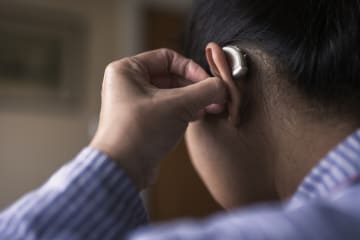
What is a hearing aid?
A hearing aid makes sounds louder. It can help some people with hearing problems to hear better. Hearing aids don't restore normal hearing. But they can make it easier to communicate.
What are the types?
There are different types of hearing aids.
- Analog adjustable hearing aids make both speech and other sounds louder in the same amount. Your doctor can adjust them to fit your hearing. You can control loudness. These cost less than the other types of hearing aids.
- Analog programmable hearing aids have a computer chip that your doctor can program to fit your hearing. They can be set up for different places or events. For example, you can have a setting for quiet one-on-one conversations and another for noisy times like a dinner party in a restaurant. You can change hearing programs with a remote control.
- Digital programmable hearing aids can adjust themselves to work best where you are at any time. You also have more choices in setting them up than with analog hearing aids.
- Bone-anchored hearing systems transmit sound through the skull. This type of hearing aid is permanently implanted in the skull bone. It may work for people who don't benefit from other types of hearing aids.
There are also different styles of hearing aids.
- A behind-the-ear (BTE) hearing aid connects to a plastic ear mold that fits inside the outer ear. BTE hearing aids are used for all levels of hearing loss, especially very severe hearing loss. They may be better for children for safety and growth reasons. Poorly fitting BTE ear molds or a buildup of earwax may cause a whistling sound (feedback).
- An in-the-ear (ITE) hearing aid fits in the outer part of the ear. It can be used by people with mild to severe hearing loss. ITE hearing aids can be used with other hearing devices, such as a telecoil that improves hearing during phone calls. ITE hearing aids can be damaged by earwax and fluid draining from the ear. Their small size may be hard for some people to handle. They aren't often used in children. That's because the case must be replaced as the child grows.
- An in-the-canal (ITC) hearing aid fits into the ear canal. ITC hearing aids are used by people with mild to moderate hearing loss. They are made to fit the shape and the size of your ear canal. They can be damaged by earwax and fluid draining from the ear. Their small size may be hard for some people to handle. They are not made for children.
- With a bone-anchored hearing system, the sound processor sits behind the ear. No part of the system is within the ear itself.
Who can prescribe hearing aids?
If you have hearing loss and are thinking about getting hearing aids, you have some options.
You can go to your doctor or audiologist. They will do a hearing test and help you decide which type and style of hearing aid may be best for you.
If you're age 18 or older and your hearing loss is mild to moderate, you might think about getting over-the-counter (OTC) hearing aids. Your doctor can help you decide if these hearing aids are right for you.
What else should you know about hearing aids?
Find out if your insurance covers hearing aids. They can be expensive. Different types of hearing aids come with different costs. Ask if the price includes ongoing support and service. Also find out about a warranty or return policy in case you aren't happy with your hearing aids.
Follow-up care is a key part of your treatment and safety. Be sure to make and go to all appointments, and call your doctor if you are having problems. It's also a good idea to know your test results and keep a list of the medicines you take.
Where can you learn more?
Go to http://www.healthwise.net/patientEd
Enter K597 in the search box to learn more about "Learning About Hearing Aids".
Current as of: September 27, 2023
Author: Ignite Healthwise, LLC Staff
Clinical Review Board
All Healthwise education is reviewed by a team that includes physicians, nurses, advanced practitioners, registered dieticians, and other healthcare professionals.

